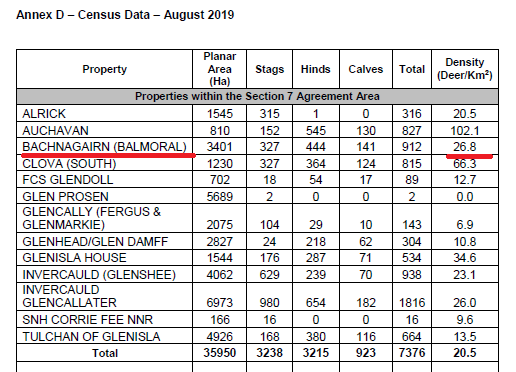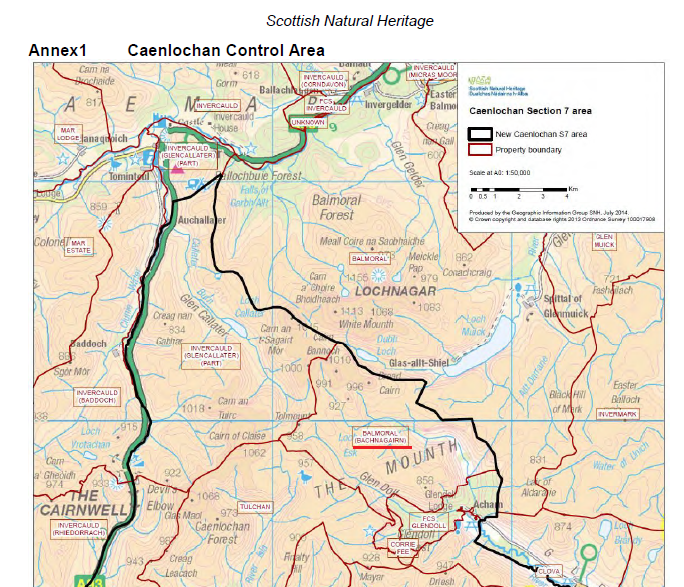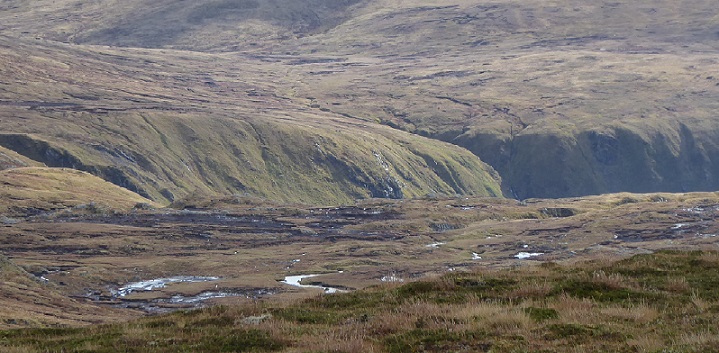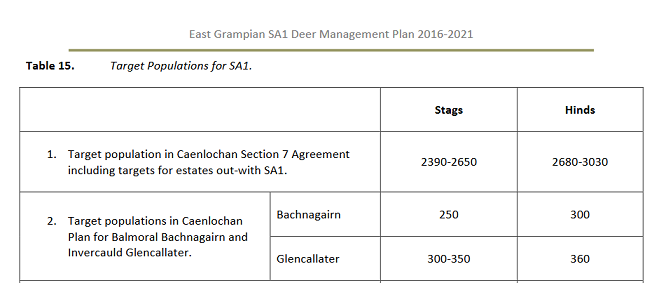
I have written several posts on parkswatch about the Royal Family’s environmental hypocrisy (see here for example), advocating action to tackle the climate and nature crises to the world while doing the opposite on the land they own in Scotland. But until now it has been very difficult to show simply how bad this is.
While Balmoral may not have had the highest deer density of the estates around Caenlochan – a former national nature reserve that was declassified because deer browsing and trampling had destroyed most of what was valuable within in – the figure of 26.8 deer per square kilometre is absolutely shocking.
The number of red deer at Balmoral in context
The numbers of deer in Scotland have almost doubled since 1990 causing damage not just to the natural environment but forestry and farming interests (see here for example) while the actions of Scottish Natural Heritage – the government agency responsible – to try and control this have been an abject failure. As a result the Scottish Government set up an independent review of deer in Scotland in 2017 . This reported in 2019 and made a large number of recommendations, including about the number of red deer the land could sustain (density of deer per square kilometre) without suffering damage.
In March 2021 the Scottish Government finally responded to the recommendations in the report of the Deer Working Group (see here). Among the many recommendations they accepted was number 86 “that SNH [now NatureScot] should adopt 10 red deer per square kilometre as an upper limit for acceptable densities of red deer over large areas of open range in the Highlands, and review that figure from time to time in the light of developments in public policies, including climate change measures”.
The Scottish Government also accepted in principle recommendation 39 that the Cairngorms National Park Authority and SNH “should have a much greater focus on the need to improve the management of wild deer in the Cairngorms National Park, to reduce deer densities in many parts of the Park to protect and enhance the Park’s biodiversity” and suggested this should be considered as part of the National Park Partnership Plan (NPPP) 2022-27.
In effect what the Deer Working Group was saying was that while a number of landowners had significantly reduced deer densities in the National Park (with outstanding results for natural regeneration in places like Glen Feshie and the northern part of Mar Lodge where numbers had dropped to 2 deer per kilometre) neither the Cairngorms National Park Authority nor SNH had done much to tackle the stalking estates which had chosen to keep numbers high.
Since then the CNPA’s NPPP, which has now been approved by Scottish Ministers, has set a target of “Average open range red deer densities in each deer management group are a maximum of five to eight per km2 by 2030.” Based on the evidence of what has happened at Mar Lodge and Cairngorms Connect, over 5 deer per square kilometre is still almost certainly too high to enable natural regeneration but will slow the damage to the natural environment that has been caused by overgrazing. Climate emergency, what emergency? Nature crisis, what crisis.
One of the primary reasons it has taken so long for both the Scottish Government and the CNPA to get to this position in my view has been the power and influence of the Royal Family at Balmoral. Where the Royal Family’s management of land is concerned, others follow or fear to challenge.
Hence why the figures for Bachnagairn, the part of Balmoral that had been covered for years by a Section 7 Agreement (a voluntary agreement between SNH and landowners to reduce deer numbers), are so important. They show just how little the Royal Family has done to address the numbers of red deer on their land despite years of being asked to do so.

In June this year the South Grampian Deer Management Group, which covers the Section 7 control area, issued a news release in which their Independent Chair (and CNPA Board Member) Doug McAdam stated:
“Red deer numbers in the area from a recent count in March 2022 sit at around 6,974, down nearly 24% from a population of 9,135 in January 2019. This represents the result of sustained culling in the area over the last four years but, for the Group to achieve what is required and deliver for both the public and private interest, more needs to be done and deer numbers will have to be reduced further”
Extrapolating from this, in the absence of other publicly available figures, deer density at Bachnagairn won’t be as bad as 26.8 and is now more likely to be around 20 per square kilometre. This is still double the maximum recommended by the Deer Working Group report and the damage that is being caused by these very high numbers of deer is significant

The target deer density for the estate, as agreed with SNH/NatureScot for the last five years, was not fit for purpose: 
That target would have resulted in 16.58 deer per square kilometre, still way above the recommendation of the Deer Working Group.
Back in 2019, with a count of 771 stags and hinds and 141 calves Balmoral was far from attaining that target and even accepting that the Deer Management Group has made a big push since then it appears unlikely – as Doug McAdam highlighted – that they will have met this.
The need for transparency
I do not believe the environmental destruction that has been going on at Balmoral for years would have continued for as long as it has if there was more transparency. The figures would have shamed the Royal Family, who can easily afford to pay for more stalkers unlike some of the smaller estates, farmers and forest businesses, to take action.
Unfortunately, despite the recommendations of the Deer Working Group for more openness about deer numbers and culls, there is still very little transparency and what information there is on Deer Management Group websites is often several years out of date.
Indeed, it took three months for NatureScot to provide any information in response to the information request I made in April (this is not the fault of frontline staff, they are under a great deal of pressure). I was forced into requesting a review about their failure to provide any information, which they responded to but redacted all the data about deer counts and culls from the information provided (which must have caused staff hours of work).
NatureScot only relented after I quoted the Deer Working Group report to them:
“Wild deer in Scotland are a national asset in the public domain and the Group considers that there should be a publicly accessible National Cull Database (NCD) to provide transparency and accountability over cull levels, so that the information is available to public bodies and other interests, including researchers and local land owners.”
Well put! I now intend to submit further FOIs to extract all the information Nature Scot and the CNPA hold about deer numbers elsewhere on Balmoral. It would be much better if they proactively published this information, which is in the public interest, rather than continuing to cover up the hypocrisy and protect the sporting interests of King Charles who, it appears, likes having lots of deer as this makes them easier to shoot.
The Deer Working Group examined the effectiveness of section 7 control agreements across the whole of Scotland – the worst performing area was Balmoral and its neighbouring estates in the Caenlochan area where nearly 20 years of repeated attempts to use the section 7 powers to control deer numbers had failed. This is why the DWG identified, in recommendation number 75, that these estates and their deer management needed a special investigation by the Scottish Parliament:
75 The Working Group recommends that the Environment, Climate Change and Land Reform Committee of the Scottish Parliament should consider holding a short inquiry into the use of section 7 Control Agreements under the Deer (Scotland) Act 1996 in the Caenlochan area (paragraph 68).
I look forward to the day when King Charles appears before this Parliamentary Committee to explain why Balmoral and its neighbours have been setting such an appalling example of poor deer management over many decades. Before he appears before the Committee perhaps his Majesty could visit Glen Feshie and meet with the owner, Anders Povlsen, who can demonstrate how to manage red deer properly in order to naturally regenerate the Caledonian pine forest and restore ecologically degraded habitats from forest to mountain summit. Only then will his Majesty be able to explain to the Committee how he intends to solve the problems on Balmoral and its neighbours.
Super work. Thank heavens someone is addressing the elephant in the room. Royal hypocrisy revealed, statutory bodies and politicians too chicken to act or corrupt,
As just one small holder in Scotland ( a registered croft ) I am required by law to fill out a deer survey annually. This croft is tiny in the overall scheme of things . Along with neighbouring crofts without deer fences, who can benefit from teh crofting grant system , this .Gov survey is wholly unconcerned about barrier fencing. For any small parcel of land, this defect renders the survey exercise when applied to open land quite meaningless. We possibly all record the same deer numbers, and/or deaths, or none. Largely un-culled around here, uncontrolled today huge numbers of marauding deer move within this district. They hardly notice any boundary. The larger surrounding estates some of which who do ” sell ” some guided shooting “experiences” hold all the ” cull” cards.
For a very thorough analysis of the situation (as published last year) the John Muir Trust webpages are well worth study. The ecological and social problems- to say little about winter night road risks – that surround the present extraordinarily high number of free range deer across the Highlands are well set out . The webpages back up Nick’s well researched piece and are well worth time for an additional read. https://www.johnmuirtrust.org/resources/943-deer-management-faq-july-2021
Thanks Dave,
An interesting read. One of the major issues is how overpopulation by red deer has lead to their spread far afield. The Coreen hills where we are had no red deer when we first came here but now they are being counted by the hundred and local farmers are complaining about the damage to their crops. It is noticeable also that they are moving down the hill to more settled inhabited areas. The spread of small woodlands in lower ground is actually creating a similar lowland habitat in which they occur in Germany
The Crown is an institution of the ruling class. Everything they say is incompatible with what they do. They’re masters of shallow, superficial puff pieces and hype. They’ve turned “green” into a business for the transnational global corporations and Wall St/City of London bankers. They’re a threat to working class communities in the UK and in the Global South. The “Greta Project” is total theatre. The Pied Piper isn’t in it. They’re using her and the rest of the kids to front the heist of the century. It’s been the Green Neo-Liberal Agenda since the Rio Earth Summit in 1992. SNH? Champions of impotence and inertia. They have a HQ in the Clydebank Business Park, Caspian House. We’re paying for it but nobody here knows or cares it’s there.